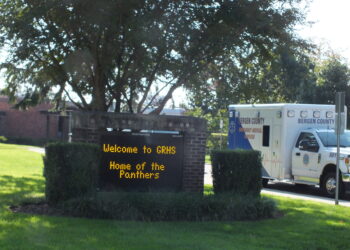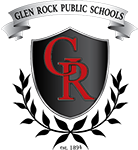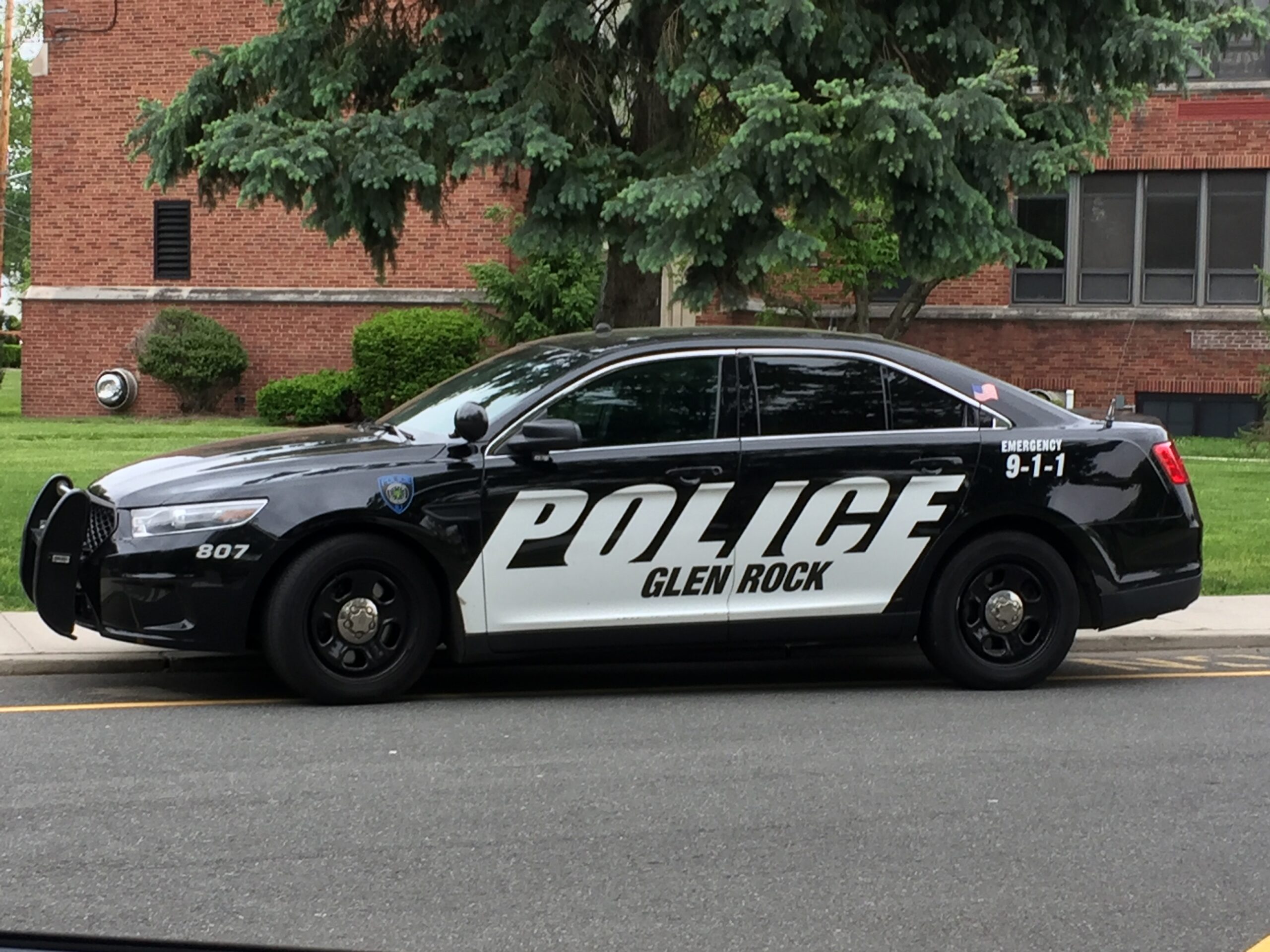Above: Board of Education president Bryon Torsiello, left, Schools Superintendent Paula Valenti and district Business Administrator Mike Rinderknecht at Monday’s meeting.
The Glen Rock Board of Education voted Monday to approve a tentative school budget for the 2017-18 school year of $51,042,107, a budget that represents a 2.99 percent increase over the 2016-17 budget, but will include middle school sports and also include the one-to-one initiative that will provide laptops for high school students.
The board will dip into its “banked cap’’ to pay for the laptop initiative, as the budget exceeds the 2 percent increase allowed by state law. School districts that do not reach the 2 percent increase the law allows in any given budget year are allowed to “bank’’ the difference between the allowed 2 percent and the actual increase, and save it to use in later years. By not reaching that 2 percent cap in past years, Glen Rock had “banked cap’’ available to allow it to exceed the 2 percent limit for this budget.
According to school district Business Administrator Michael Rinderknecht, the 2.99 percent increase will mean an increase in taxes of roughly $168.60 on a home assessed at $558,279, which is the average assessment for a home in Glen Rock.
The major controversy in the budget discussions had been the proposal to eliminate six sports at Glen Rock Middle School. To save money, the board had initially voted to cut the sports – boys and girls soccer, boys and girls basketball, baseball and softball – which are offered by the borough in its youth recreational and travel sports programs. Cross country, volleyball and track and field, which are offered by Glen Rock Middle School and not offered in any form by the borough at the youth level, were not targeted to be dropped.
But the backlash from the public against the decision to eliminate the sports prompted the board to reverse course and try to find a way to keep them in the budget. To make that happen, the board agreed at its March 6 meeting to raise the sports activity fees at the High School and Middle School. The sports activity fee at the high school remains $150, but instead of paying the fee only one time, to cover all sports and activities a student takes part in, students who participate in multiple sports will now pay the activity fee for the first two sports. If they play a third sport, that would be free. So a student at the High School who plays sports in each of the fall, winter and spring seasons would pay $300 in activity fees, as compared to $150 in 2016-17. The Middle School sports activity fee goes up from $75 to $100, and the same rule applies that a multi-sport athlete would pay the activity fee for the first two sports.
There also is now a separate “club fee’’ to cover non-sports activities. In the past, the same activity fee was required for any extra-curricular activity. The new club fee is $75 for the High School and $25 for the Middle School and is a one-time fee covering all non-sports activities.
The tentative budget includes $986,900 for capital projects, including roof replacement/restoration at the High School/Middle School; floor tile replacement at Byrd and Coleman schools; a replacement of a heating/air conditioning unit on top of the High School/Middle School and a repair/replacement of the tennis courts at the High School. Board member Eileen Hillock asked whether there was any chance of voting separately on the tennis courts, which are scheduled to cost $278,000 to repair. However, Rinderknecht said if the tennis courts repair – or any other item – were to be removed from the capital improvement list, it would then be removed from the budget altogether and would have to wait at least until the 2018-19 school year to be addressed. Board member Elizabeth Carr said the damage to the tennis courts could be a safety hazard, and therefore should not wait a year to be fixed.
Carr and Hillock both questioned the increase in the district’s travel budget, which is $85,740 for 2016-17 and bumps up to $97,225 for ’17-18. Rinderknecht explained that the increase was due to the district negotiating last year to pay up to $10,000 for up to four administrators to travel to national conferences. Rinderknecht said the travel budgets are usually estimated on the high end, and that whatever money isn’t used goes into the district’s surplus, which then can be appropriated and used in the following year’s budget. Hillock argued that since there is money left over in the existing travel budget for 2016-17, the district should be able to absorb the additional $10,000 without having to increase the travel budget for next year. She ultimately voted yes to the overall budget, but with an exception to note her opposition to increasing the travel budget.
The topic of Glen Rock High School joining the Big North Athletic Conference did not come up. And with the budget passed, the board voted to cancel its scheduled March 20 meeting, meaning the Big North discussion will not come up again until the next scheduled meeting, March 27.



















healing meditation
Если вы ищете способ быстро получить финансовую поддержку, не беспокоясь о своей кредитной истории или текущем статусе занятости, mikro-zaim-online.ru предлагает решение. На нашем сайте представлены [url=https://mikro-zaim-online.ru/bez-otkaza/]онлайн кредиты на карту без отказа[/url] от МФО, готовых помочь вам в трудную минуту. Мы верим, что каждый заслуживает шанс на финансовое благополучие и стремимся сделать его доступным для всех.
В поисках быстрого и надежного способа получить денежные средства без лишних формальностей? Mikro-zaim-online.ru упрощает этот процесс, предлагая [url=https://mikro-zaim-online.ru/bez-otkaza/]займы всем без отказа[/url]. Единственные требования – это наличие паспорта и возраст 18 лет. Никаких сложных проверок кредитной истории или необходимости доказывать свою платежеспособность. Выбирая из предложений более 40 МФО, каждый имеет шанс получить до 30 000 рублей под свои нужды. Это уникальная возможность обеспечить себя необходимыми средствами мгновенно и без хлопот.
На [url=https://all-credit.ru/]all-credit.ru[/url] мы создали уникальную подборку МФО, предлагающих займы всем – от студентов до домохозяек, а также тем, кто столкнулся с просрочками и имеет плохую кредитную историю. У нас есть предложения, где можно получить деньги в займ до 10 000 рублей без строгих условий, что делает финансовую помощь доступной для каждого.
В termburg.ru вас ждет исключительный отдых в лучших традициях заботы о себе. Термальный комплекс Термбург — это не просто баня, это целый мир, где каждая деталь продумана для вашего максимального комфорта и удовольствия. Погрузитесь в мир тепла и расслабления с нашими уникальными водными процедурами, насладитесь целебным воздействием травяной сауны и позвольте себе роскошь настоящего отдыха. Забудьте о повседневной суете, позвольте себе немного роскоши и восстановления в Термбурге. Запланируйте свой идеальный день релаксации уже сегодня!
ТЕРМБУРГ – [url=https://termburg.ru/]термы печатники[/url]
Адрес – Москва, Гурьянова 30 (2 этаж)
Сияйте светом возможностей вместе с нашими микрозаймами! Наш сайт – это мостик к вашим мечтам и целям, который поможет перейти через любые финансовые реки. Мы предлагаем займы без отказов, с которыми вы сможете мгновенно решить свои финансовые задачи, даже если ранее сталкивались с трудностями. С нашими предложениями, доступными круглосуточно, вы всегда будете на шаг ближе к реализации своих планов.
[url=https://images.google.mu/url?q=https://mikro-zaim-online.ru/]Займы без скрытых платежей[/url]
[url=https://image.google.sr/url?q=https://mikro-zaim-online.ru/]Займы: быстрый выход из финансовых затруднений[/url]
[url=https://images.google.by/url?sa=t&url=https://mikro-zaim-online.ru/]Быстрый займ: когда срочно нужны деньги[/url]
[url=https://www.google.cl/url?q=https://mikro-zaim-online.ru/]Новые малоизвестные займы: стоит ли пробовать?[/url]
[url=https://maps.google.com.pe/url?sa=i&url=https://mikro-zaim-online.ru/]Срочный займ: деньги в долг быстро[/url]
Сенсорная панель оператора купить smart-engineer.ru
Представляем Вам фирму Смарт-Инжениринг, которая реализует разнообразное оборудование для Вашего бизнеса. В нашем современном мире всё так быстро прогрессирует, что уже скоро роботы будут им управлять. Поэтому, пока это не произошло, рекомендуем Вам ознакомиться с перечнем оборудования для промышленной автоматизации на сайте smart-engineer.ru прямо сейчас.
По поиску [url=https://smart-engineer.ru/catalog/]датчики уровня innolevel[/url] заходите на указанный онлайн сайт. Данная организация предлагает оборудование, которое включает в себя приборы управления, преобразователи давления, шкафы управления, операторские панели, УПП, системы ЧПУ, контролеры машинного зрения и очень многие другие. Ознакомьтесь с подробным каталогом на данном сайте.
Мы уже длительное время работаем в этой сфере по Удмуртии, Пермскому краю, Татарстану, Башкортостану и Свердловской области. Сейчас один из главных офисов расположен по адресу: г. Ижевск, проезд имени Дерябина, д. 3/36. Свяжитесь с нами по телефону +7(3412)23-00-32 или напишите на нашем сайте.
Если Вы искали [url=https://smart-engineer.ru/catalog/izmeriteli-regulyatory-registratory-samopiscy/izmeriteli-temperatury/termodat-22i5-izmeritel-temperatury-mnogokanalnyj.html]термодат измеритель температуры[/url] в сети интернет, то Вы на верном пути. На smart-engineer.ru есть вся информация по этому и другим вопросам. Мы рады предложить нашим покупателям широкий качественный ряд услуг, следуя только новейшим тенденциям автоматизации. Мы открыты к общению и с радостью ответим на любые вопросы, проконсультируем и направим в верное русло. А ещё, мы полагаемся на успешное и длительное сотрудничество.
Исследуйте уникальные возможности с [url=https://mikro-zaim-online.ru/mfo-2023/]новые малоизвестные микрозаймы[/url], доступные на нашем сайте. Эти предложения предоставляют быстрый доступ к финансам без необходимости длительного ожидания одобрения и с минимальными требованиями к заемщикам.
Освоите юриспруденцию на новом уровне с дистанционными курсами от Академии “МАПС”. Это идеальная возможность для тех, кто стремится получить глубокие знания в области права, не выходя из дома. Наша программа обучения предназначена для обеспечения понимания всех аспектов закона, укрепления правовой грамотности и подготовки к успешной карьере в юриспруденции. Начните свой путь к успеху уже сегодня!
Maps-Edu – [url=https://maps-edu.ru/catalog/logopediia?type=professionalnaya-perepodgotovka]логопед переподготовка на базе высшего образования[/url]
Сервисный центр [url=https://indesit-ekaterinburg.ru/]indesit-ekaterinburg.ru[/url] предлагает профессиональный и гарантированный ремонт бытовой техники Indesit по доступным ценам. Мы гарантируем, что после ремонта в нашем сервисном центре ваша техника Indesit будет работать как новая, так как мы выполняем все виды работ, от диагностики до замены деталей. Обратившись к нам, вы получите не только высокий уровень сервиса, но и приятные бонусы, такие как бесплатная диагностика, выезд мастера на дом и скидки на последующие обращения.
По вопросу [url=https://mudryakova.ru/]дизайн студия спб[/url] заходите на представленный онлайн ресурс. Осуществляем работу с совершенно разными идеями, как под ключ, так и с едиными небольшими комнатами. Начинаем работу, естественно, со знакомства с вами, ведь любой интерьер создается под владельца квартиры, всю семью или руководителя кафе. У каждого человека личные требования, назначения помещения, образы жизни и нравы, а также планы и пожелания. Мы стараемся учесть все мелочи и сочетать их в эксклюзивном дизайн проект.
Портфолио дизайна интерьера mudryakova.ru
If you’re on the hunt for new shoes but dread the thought of overspending, let me introduce you to Zesc Analytics. This platform is a game-changer, offering real-time price tracking and alerts for price drops. It’s like having a personal assistant who’s always on the lookout for the best deals. Before making any purchase, check Zesc Analytics to ensure you’re getting the best price available. It’s an easy step that can save you a lot of money in the long run.
Analytics.zesc.pro – [url=https://analytics.zesc.pro/]shoe closeout deals[/url]
Что касается [url=https://sansmail.ru/catalog/brands/ido]душевая кабина ido showerama[/url] заходите на наш веб ресурс. В наше современное время дизайнеры и даже сами обладатели квартир делают из простых помещений красивые произведения искусства и максимально уютные условия. Ванная комната не значится исключением, из них получаются шикарные интерьеры с наличием душевой кабины, унитаза и раковин. В данном в каталоге Вы увидите: ванны, душевые кабины, сауны, душевые поддоны, трапы, писсуары, душевые стойки и панели, раковины, полотенцесушители, светильники, аксессуары и многое другое
Интересуетесь, как юридический аутсорсинг может уменьшить ваши бизнес-расходы? Посетите наш сайт svoyuristonline.ru и ознакомьтесь с разнообразием предложений и [url=https://svoyuristonline.ru/]юридическим аутсорсингом цены[/url], которые мы предлагаем. Наши услуги помогут вам сэкономить на содержании штатного юриста, при этом обеспечив полный спектр юридического сопровождения вашего бизнеса. Выберите подходящий вариант и начните экономить уже сегодня.
Зеркало БК действующее на сегодня
Что касается [url=https://trinixy.ru/246790-bukmekerskaya-kontora-mostbet-stavki-na-sport-i-vhod-na-sayt.html]most bet[/url] вы сможете найти всё о ставках на спорт, бонусы новым игрокам и прогнозы. Так как ставки на спорт официальные сайты букмекеров регулярно банят, то делаются рабочие площадки — зеркала. У нас Вы сможете войти в такие бк, как мостбет, marathonbet, мелбет, 1xbet и другие. Только самые известные и проверенные конторы, за которые не стоит волноваться.
Встречайте новые возможности для активного образа жизни с PUMA Moldova! Мы предлагаем вам самый широкий ассортимент спортивных товаров: от ультрамодных кроссовок до функциональной одежды для тренировок. Подчеркните свой стиль уникальными аксессуарами и наслаждайтесь комфортом во время любой активности. Приглашаем вас в наши магазины, где вы найдете не только новинки и лучшие предложения, но и профессиональную консультацию. Сделайте свой выбор с PUMA Moldova и двигайтесь вперед к новым достижениям!
Pumamoldova.md – [url=https://pumamoldova.md/ru/shop/male/footwear]магазин мужских кроссовок[/url]
Контакты и адрес – Молдова, г. Кишинев
Магнитно порошковый контроль ndt.su
Если Вы желали найти [url=https://ndt.su/id/ochistitel-inspektor-cln-aerozol-500ml-144.html]капиллярный набор аэрозоль[/url] в интернете, то переходите на указанный сайт ndt.su прямо сейчас. Мы уже много лет работаем в данной сфере и понимаем свои продукты превосходно. Также с радостью готовы порекомендовать необходимые продукты именно для сложившейся ситуации. Мы используем в работе детали сугубо Российского происхождения, разумеется нам это помогает держать цены на уровне, при этом не упуская в качестве. Будем рады сотрудничать с Вами.
Мы находимся по адресу: РФ, Удмуртская республика, г. Ижевск, ул. Красногвардейская, д. 60, оф. 13. По любому вопросу звоните по телефону 8(800)555-45-19 или пишите на электронный адрес. Режим работы пн-пт с 9:00 до 18:00, сб и вс выходные.
Исследования показывают, что использование портала zaim-fin.ru может способствовать улучшению финансовой грамотности у пользователей. Благодаря доступу к информации о займах от различных МФО, а также советам по управлению финансами, пользователи могут развивать навыки управления личными финансами и принимать более обоснованные решения о своих финансах. Таким образом, портал zaim-fin.ru не только предоставляет финансовые возможности, но и играет роль в повышении уровня финансовой грамотности в обществе.
Imagine this: you’re on the verge of unveiling your latest masterpiece to the world on Instagram – a breathtaking snapshot of a sunset painting the sky in hues of pink and gold. You’re brimming with excitement as you go to share it with your followers, only to find yourself locked out of your account. Panic sets in, but then you remember a friend mentioning a magical website called [url=https://instagram-deactivated.com/]blocked instagram[/url] . With a leap of faith, you visit the site and are greeted by a team of digital wizards ready to weave their magic. Through their ingenious methods and boundless creativity, they guide you through the process of account recovery with ease. Before you know it, you’re back in the driver’s seat, sharing your moments of joy and beauty with the world. Thank you, [url=https://instagram-deactivated.com/]instagram unblocked[/url] , for turning a moment of frustration into a triumph of creativity!
Не зря говорят, что в Москве проститутки самые красивые и раскрепощенные. Они могут доставить такое наслаждение, которое мужчина никогда не получит в постели с женой ли подругой. Все дело в техниках удовлетворения, которыми путаны владеют в совершенстве. Они без проблем делают горловой минет, позволяют иметь их в попу и т.д. Найти проститутку не сложно — достаточно открыть сайт [url=https://newswomanblog.win/]newswomanblog.win[/url]. Здесь размещены анкеты путан, среди которых можно легко выбрать девушку по своим запросам в плане внешности и других параметров.
Thank you for your sharing. I am worried that I lack creative ideas. It is your article that makes me full of hope. Thank you. But, I have a question, can you help me?
Обучение по охране труда в дистанционном формате предоставляет возможность специалистам из любой точки страны получить квалифицированные знания и навыки для эффективного управления безопасностью труда на производстве. Дистанционные программы позволяют изучать материал в удобном ритме, совмещая обучение с работой. Курсы охватывают весь спектр вопросов охраны труда, включая законодательные и нормативные основы, методы предотвращения профессиональных рисков, организацию безопасных условий труда.
Поднимите свой уровень: [url=https://maps-edu.ru/akkreditaciya-medrabotnikov]периодическая аккредитация врачей[/url] и специалистов по социальной работе.
Embrace the future of plastic recycling with Rostpolikraft’s cutting-edge equipment. Specializing in machines that transform plastic waste into granules and innovative polymer sand production technology, we empower businesses to achieve sustainability goals while maximizing profitability. Our portfolio includes everything from plastic processing machines to complete recycling solutions. Choose Rostpolikraft for unparalleled efficiency and environmental responsibility. Experience the difference in quality and performance with our equipment, tailored to your production needs.
Eng.18ps.ru – [url=https://eng.18ps.ru/catalog/single-stage-pelletizing-machine/single-stage-pelletizing-machine.html]machine for processing plastic into granules price[/url]
В жизни каждого ноутбука или планшета рано или поздно случается ситуация, когда необходим срочный ремонт. Если ваше устройство Lenovo вышло из строя, не отчаивайтесь! Опытные мастера сервисного центра https://servisnyjcentr-lenovo.ru/ готовы прийти на помощь. Наши инженеры имеют многолетний опыт в диагностике и устранении любых неполадок техники Lenovo. Будь то программный сбой, механическое повреждение или неисправность комплектующих – специалисты центра быстро вернут работоспособность вашему гаджету. Мы предлагаем доступные цены на ремонт и гарантируем использование только оригинальных запчастей от производителя.
[url=https://servisnyjcentr-lenovo.ru/]сервисный центр lenovo в москве[/url]
леново сервис
леново замена материнской платы
поменять экран на ноутбуке леново
3D вид товара для Вашего сайта arigami.tech
По теме [url=https://arigami.tech/]изображение товара 3d[/url] Вы на правильном пути. Мы даем гарантию на высокое реальное качество после переноса его в 3D вид. Весьма просто будет коммуницировать с виджетом, изменяя в настоящем времени вариации, цвета, габариты. Исключительный путь к реализации может дать Вам известность и исключительность в своей сфере. Многие покупатели подчеркивают, что осуществлять покупки интереснее и проще с подбором при просмотре 3D моделей.
Перестала нагреваться варочная панель вашей кухонной плиты Whirlpool? Возможно, проблема кроется в неполадках системы электропитания, коротком замыкании или поломке одной из конфорок. Не пытайтесь самостоятельно разбираться в причинах – это опасно для жизни из-за риска поражения электрическим током! Доверьте ремонт варочной поверхности профессионалам из https://whirlpool-rem.ru/. Наши мастера быстро выявят неисправность с помощью современной диагностической аппаратуры и устранят ее. После ремонта ваша варочная панель будет работать исправно!
[url=https://whirlpool-rem.ru/remont-stiralnyh-mashin]ремонт стиральной машины whirlpool[/url]
ремонт вытяжки whirlpool
ремонт холодильников whirlpool на дому
ремонт духовых шкафов вирпул
Создание визуальных впечатлений для Вашего бренда w2w.group
По запросу [url=https://w2w.group/solutions]разработчик дополненной реальности[/url] Вы на верном пути. Наши консультанты готовы дать обратную связь и ответить на возникшие вопросы. Если у Вас есть личные макеты, которые нужно дополнить реальностью, отправляйте их нам и мы сумеем понять, подойдут ли они. Если их нет, мы самостоятельно можем их создать, учитывая все Ваши желания. Оформление собственного сайта с помощью виртуальной и дополненной реальности не только удивляет покупателя, но и даёт понять уровень подхода к ведению бизнеса. Тем самым Вы можете отличиться среди других на рынке и громко заявить о себе.
В [url=https://stinol-servise.ru/]stinol-servise.ru[/url] работают опытные мастера, которые проведут диагностику и ремонт вашего холодильника Stinol на высоком уровне.
замена вентилятора в холодильнике stinol
ремонт стинол
замена пускового реле холодильника стинол
Заключить договор на вывоз мусора Москва ecologia-t.ru
По поиску [url=https://ecologia-t.ru/info/vivoz_musora_konteinerom_20m3/]вывоз мусора контейнером 20м3 москва[/url] Вы на верном пути. Осуществляем вывоз мусора разного вида: строительный, твердые бытовые отходы, вторсырье, порубочные остатки, снег и другие. Также проводим работу круглосуточно, без выходных и даже в праздничные дни. Делаем как одноразовые вывозы, так и регулярные по конкретным дням или часам, в зависимости от планов клиента. Подходим к каждой проблеме персонально, чтобы выполнять работу максимально ответственно.
Когда моя стиральная машина Bosch начала издавать странные звуки во время стирки, я сразу же вызвал мастера из официального сервисного центра. Оказалось, что нужна замена подшипников. Ремонт прошел гладко, и машина теперь работает безупречно. Мастер был очень внимательным и профессиональным, все объяснил и показал. Доволен, что обратился именно к ним, работа сделана на совесть.
Бош-Ремонт.рф – [url=https://xn—-9sbn2afcdnw7c.xn--p1ai/сервисный-центр]сервисный центр бош в москве[/url]
Моя кофемашина Gaggenau недавно начала шуметь и протекать. Обратился в сервис, специализирующийся на технике Gaggenau. Специалисты предложили бесплатную диагностику на месте, что было для меня большим плюсом. Они быстро выявили причину поломки и заменили неисправный элемент. Ремонт обошёлся недорого, выполненные работы получили гарантию на год, и теперь моя кофемашина работает идеально.
Gaggenau-Remonty.ru – [url=https://gaggenau-remonty.ru/kofemashin]ремонт кофемашин gaggenau[/url]